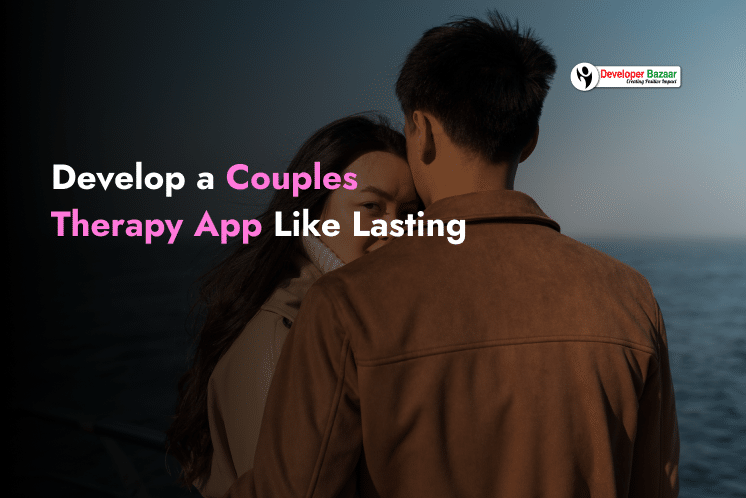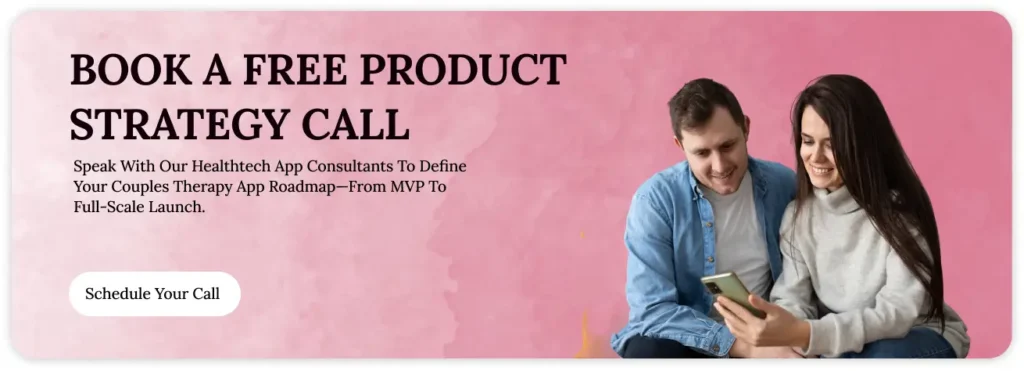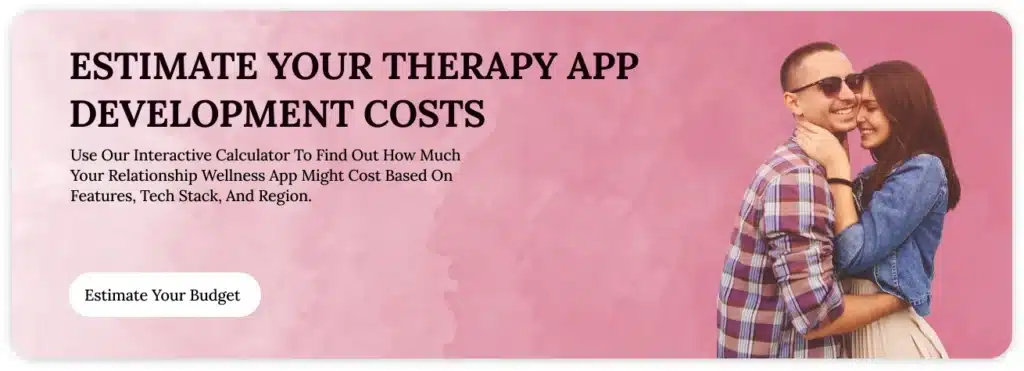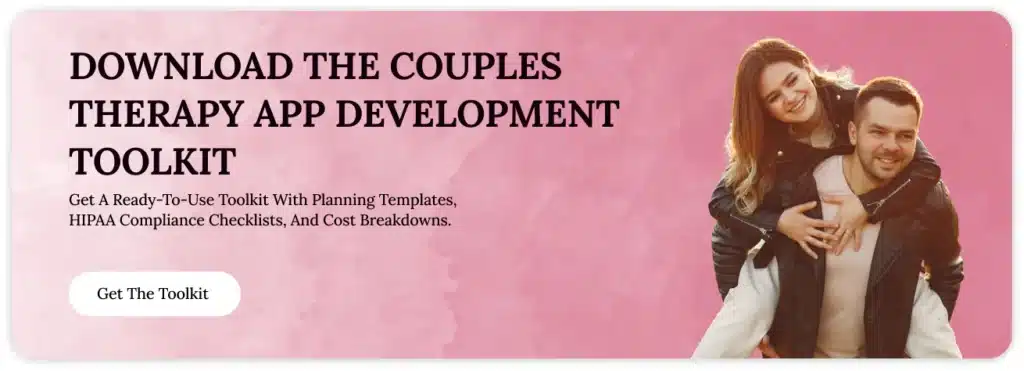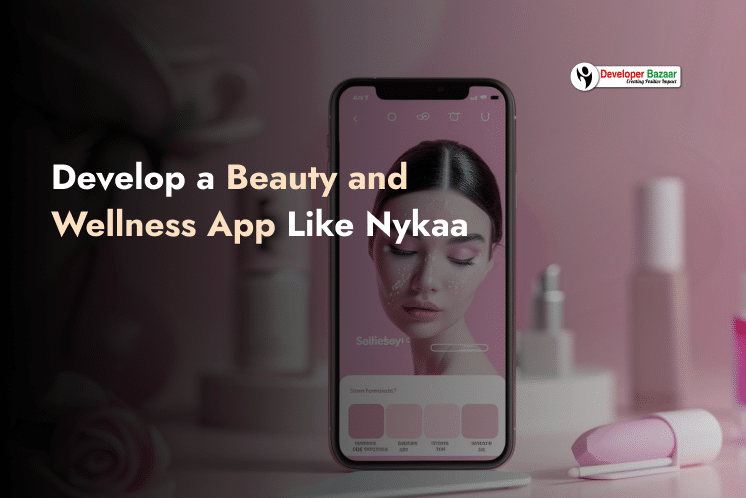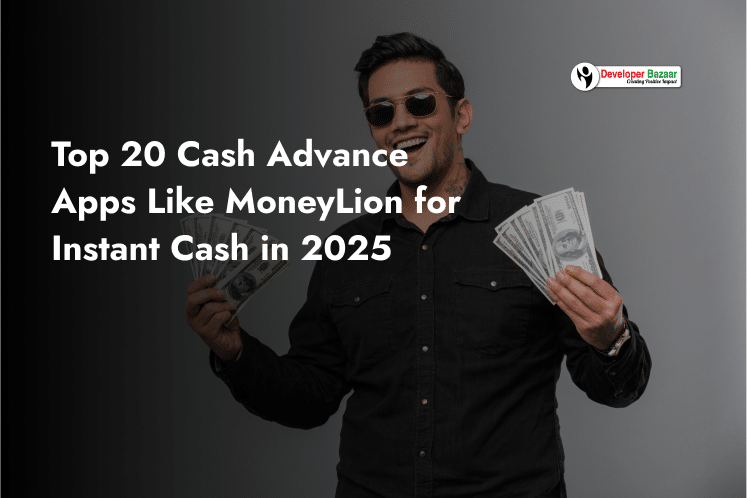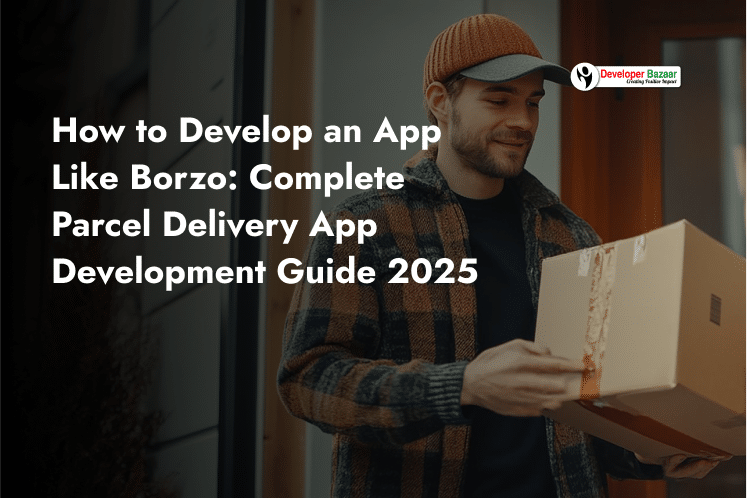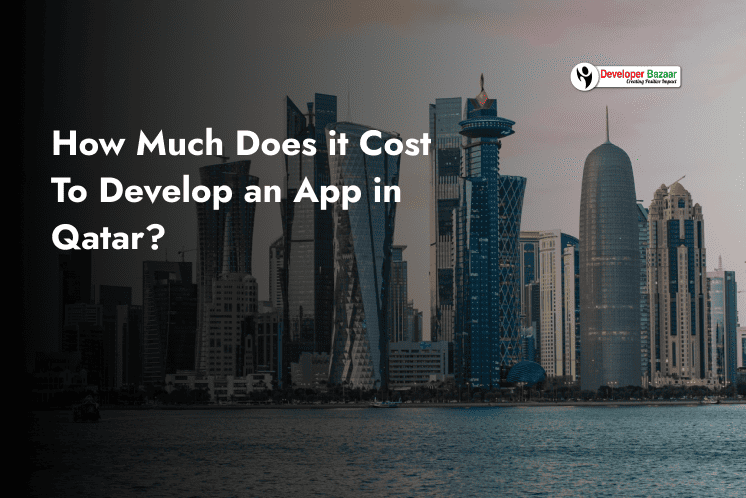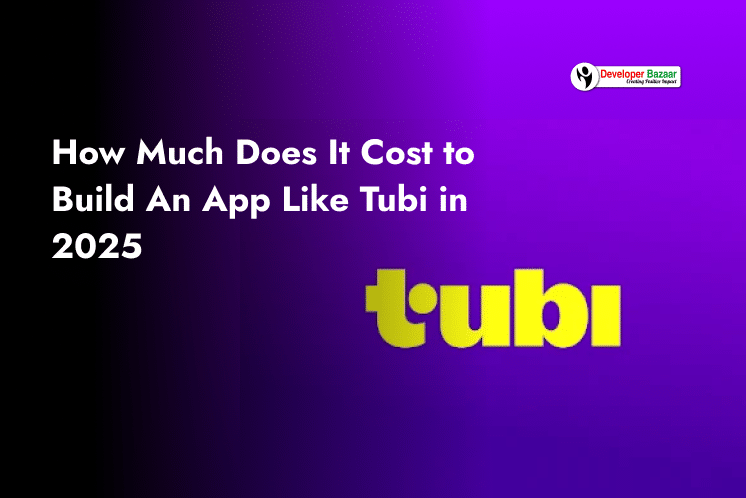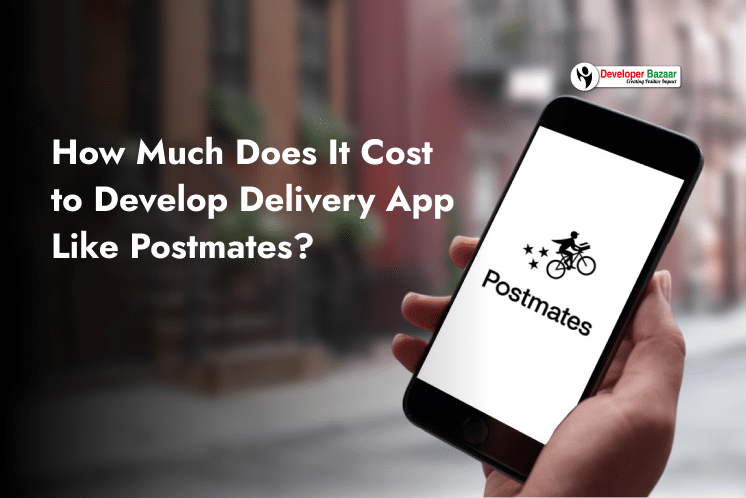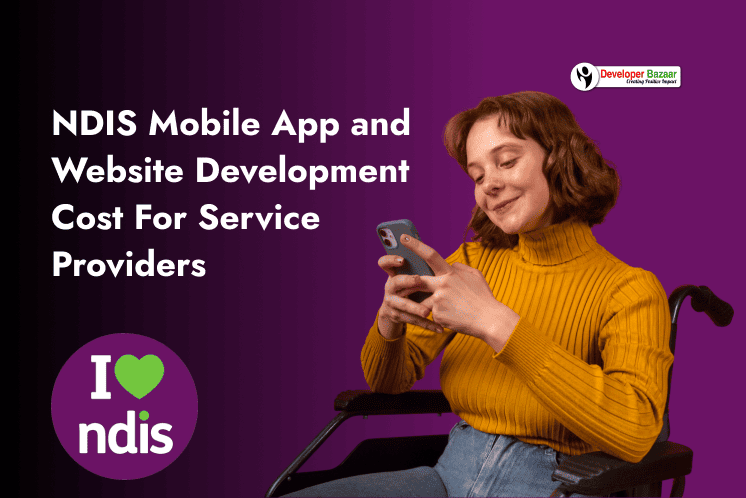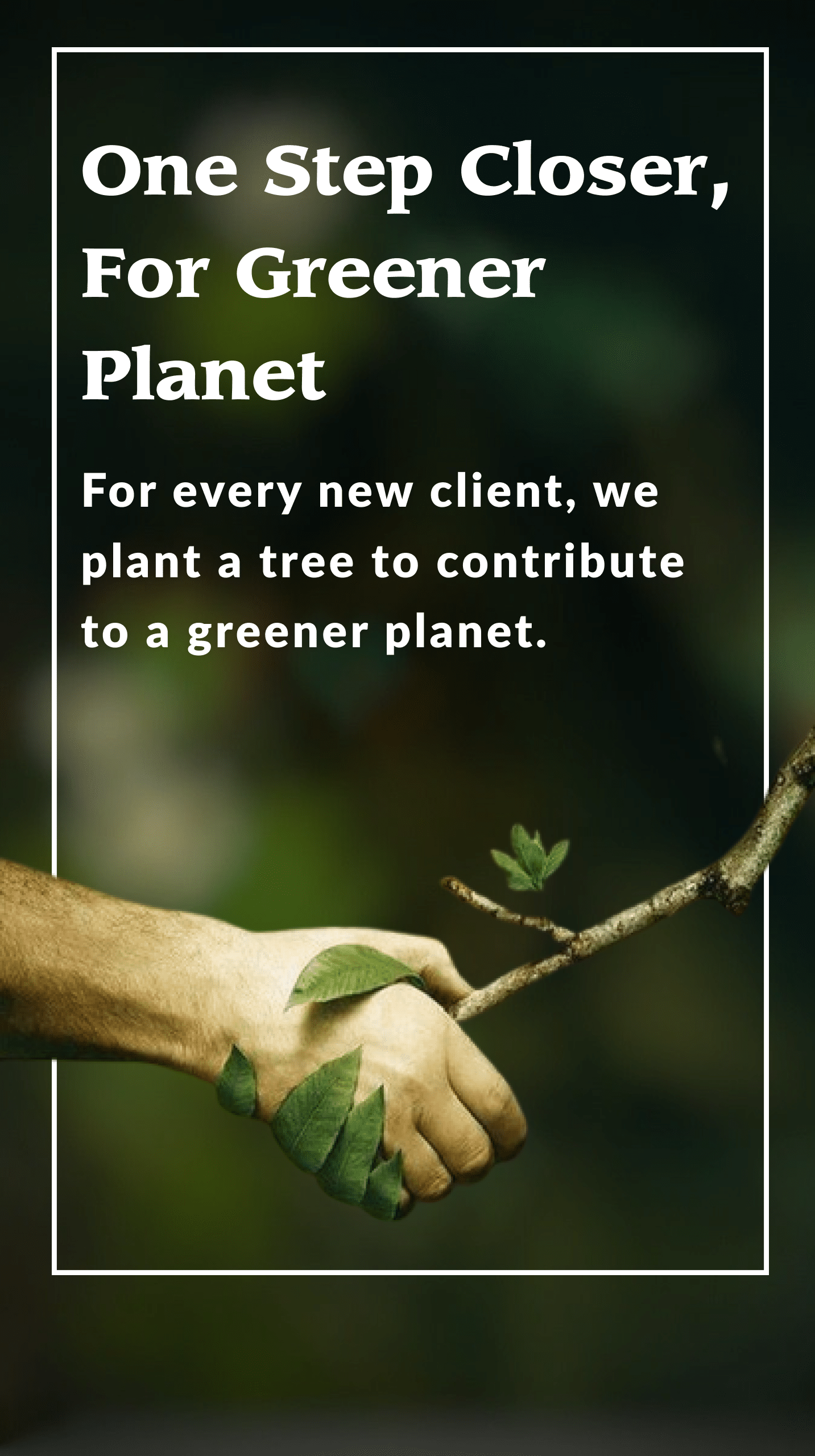Table of Contents
ToggleThe demand for digital mental health solutions is exploding as more couples turn to technology to strengthen their relationships. According to Grand View Research, the global mental health app market is projected to reach $17.5 billion by 2030, driven by increased adoption among millennials and Gen Z who prefer accessible, private solutions for relationship wellness.
Couples therapy apps represent a particularly promising niche within this expanding market. Unlike traditional therapy, these platforms offer convenient, cost-effective support that couples can access anytime, anywhere. This comprehensive guide explores everything you need to know about developing a couples therapy app like Lasting—from app development costs and essential features to monetization strategies and market opportunities.
What is Lasting?
Lasting is a leading couples therapy app that offers structured, evidence-based programs designed by licensed therapists to help partners improve communication, build intimacy, and strengthen trust. The app combines self-guided modules with personalized recommendations, creating a comprehensive relationship wellness platform that feels both professional and approachable.
1. Target Market
Lasting primarily serves millennial and Gen Z couples across the United States, United Kingdom, and Australia. These demographics value convenience, privacy, and cost-effectiveness when addressing relationship challenges. The app appeals particularly to tech-savvy couples who prefer digital solutions over traditional in-person therapy sessions.
2. Key Features That Drive Success
Lasting’s success stems from several core features that create genuine value for users. The app provides guided therapy modules based on evidence-based therapeutic approaches, personalized recommendations that adapt to each couple’s specific needs, and comprehensive progress tracking that helps partners monitor their relationship growth over time.
The platform also includes daily reminders and check-ins that encourage consistent engagement, secure messaging capabilities for private communication, and an affordable subscription model that makes relationship therapy accessible to a broader audience.
3. Why Lasting is an Ideal Reference Point?
Lasting demonstrates that evidence-based therapy combined with thoughtful personalization drives both user engagement and measurable results. The app consistently achieves higher retention rates than general wellness apps, proving couples are willing to invest in digital solutions that genuinely strengthen their relationships.
Market Stats of the Couples Therapy App Industry
The couples therapy app market is experiencing unprecedented growth, driven by changing attitudes toward mental health and relationship wellness. According to Grand View Research, the mental wellness app market was valued at $5.2 billion in 2022 and is projected to reach $17.5 billion by 2030, growing at a robust 16.5% CAGR.
Statista reports that over 60% of millennials are open to app-based therapy solutions, with relationship wellness apps seeing 30% higher retention rates compared to general mental health apps. This higher engagement reflects the personal nature of relationship challenges and the immediate value couples derive from improved communication tools.
The United States represents the largest market, followed by the United Kingdom and Germany. Average monthly spending per user ranges from $12 to $25, with premium features and personalized coaching commanding higher price points.
Business of Apps indicates that 1 in 3 therapy app users prefer hybrid models that combine self-guided modules with live professional sessions. This preference for blended approaches creates opportunities for apps that can seamlessly integrate automated content with human expertise.
The market is particularly strong among couples aged 25-40, with 45% of users reporting improved relationship satisfaction after three months of consistent app usage. These statistics demonstrate both the market opportunity and the genuine impact these platforms can achieve.
Cost to Develop a Couples Therapy App Like Lasting?
1. Overall Cost Range
Developing a couples therapy app like Lasting requires an investment between $30,000 and $150,000, depending on features, compliance requirements, and platform complexity. This range reflects the specialized nature of mental health applications, which demand higher security standards and therapeutic content expertise.
2. Cost by Complexity
| Complexity | Development Time | Cost Estimate |
|---|---|---|
| Basic | 4-6 months | $30,000-$50,000 |
| Standard | 6-9 months | $50,000-$80,000 |
| Advanced | 9-12+ months | $80,000-$150,000+ |
3. Cost Breakdown by Development Stage
| Development Stage | Cost Estimate | Explanation |
|---|---|---|
| Planning & Research | $5,000-$10,000 | Market validation, therapeutic content strategy, compliance planning |
| UI/UX Design | $8,000-$15,000 | User flows, wireframes, therapeutic interface design |
| Frontend Development | $12,000-$30,000 | User interface coding, responsive design |
| Backend Development | $15,000-$40,000 | API development, secure data handling, user management |
| Testing & QA | $5,000-$10,000 | Security testing, therapeutic content validation, bug fixes |
| Deployment | $3,000-$7,000 | App store publishing, server setup |
| Maintenance | $2,000-$5,000/month | Ongoing support, content updates, security monitoring |
4. Additional Considerations
HIPAA compliance app development can add approximately 15% to your total development budget, but it’s essential for handling sensitive relationship data. Ongoing cloud infrastructure costs typically range from $1,500 to $3,000 monthly, depending on user volume and data storage requirements.
Therapy content licensing represents another significant investment, potentially costing $10,000 to $50,000 depending on the breadth and depth of therapeutic materials you want to include.
What Factors Affect the Cost of Couples Therapy App Development?
Developing a couples therapy app involves more than just coding basic features. From security and compliance to design and platform decisions, multiple factors can significantly influence your overall budget. Here’s a closer look at the most important considerations:
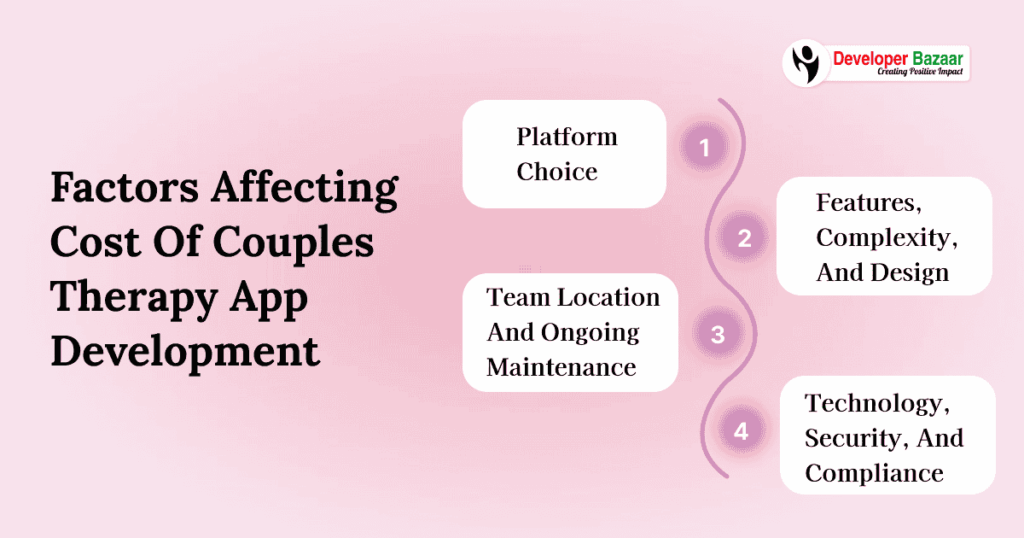
Platform Choice
Cross-platform development using frameworks like Flutter or React Native can reduce costs by around 30% compared to building separate native apps for iOS and Android. However, if your app requires advanced features—like high-performance video calls or device-specific capabilities—native development may be necessary for the best user experience.
Features, Complexity, and Design
Advanced features such as AI-powered recommendations, real-time video sessions, and detailed progress analytics can greatly increase costs. Each new capability demands specialized expertise and extended testing cycles. Additionally, investing in custom animations, therapeutic-focused design elements, and micro-interactions can add 20–25% to your budget but often pays off in better engagement and retention.
Technology, Security, and Compliance
Using HIPAA-compliant cloud services (e.g., AWS or Azure) costs more than standard hosting but is essential for handling sensitive health data. Robust security measures—like end-to-end encryption, secure authentication, and regular audits—are critical for protecting user privacy. Compliance with regulations such as HIPAA and GDPR will also add development time and ongoing monitoring expenses.
Team Location and Ongoing Maintenance
Where your development team is based can significantly impact costs. U.S. teams typically charge $120–$200 per hour, Eastern European teams $50–$90, and Asian teams $25–$50. Keep in mind that mental health apps may require cultural familiarity and regulatory expertise. Finally, plan for continuous updates, content refreshes, and security monitoring—ongoing maintenance is often more intensive than for general consumer apps.
Key Features to Add for Couples Therapy App Development
A successful couples therapy app needs more than video calls or chat tools. To create a meaningful impact and sustained engagement, your app should combine evidence-based interventions, personalized experiences, and robust support features. Here are the essential components to consider:
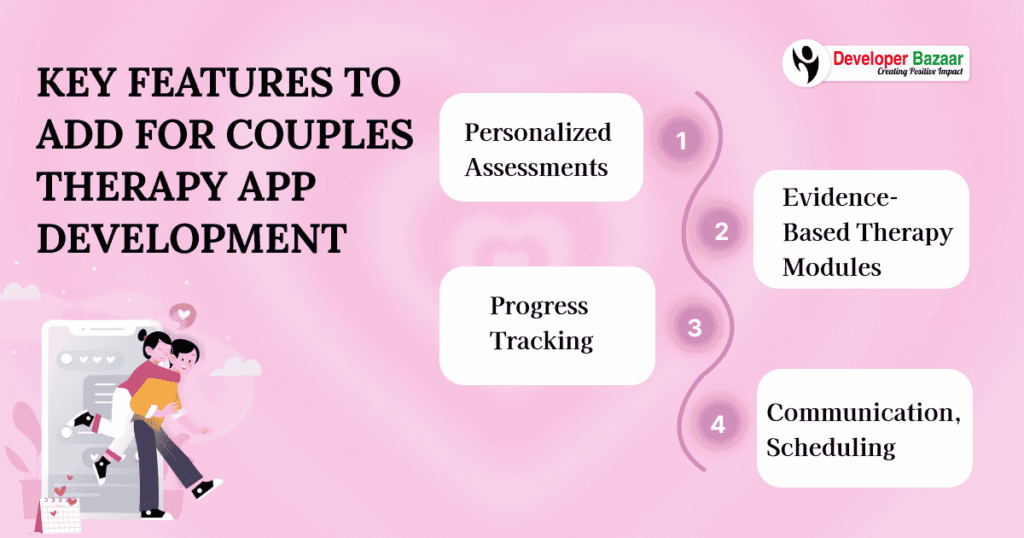
Personalized Assessments and Guided Modules
Comprehensive onboarding surveys that assess communication styles, relationship goals, and specific challenges lay the groundwork for a customized experience. These relationship assessments should be created in consultation with licensed therapists to ensure clinical validity and relevance. To take personalization further, AI-powered recommendations can analyze each couple’s behavior, engagement patterns, and progress over time. Based on these insights, the app can suggest tailored exercises, content, and therapeutic approaches that adapt as users evolve.
Evidence-Based Therapy Modules and Resources
Structured therapy modules are the core of any effective couples therapy app. These guided exercises focus on improving communication, building intimacy, resolving conflicts, and fostering trust. Modules should progress in a logical sequence so couples build on their skills step by step. In addition to interactive modules, a comprehensive resource library adds value by offering curated articles, instructional videos, and therapist-developed materials. These resources support learning outside of structured exercises and empower users to deepen their understanding at their own pace.
Engagement and Progress Tracking
To help couples stay motivated, visual dashboards can track progress across key milestones, completion rates, and other indicators of growth. Seeing tangible improvements reinforces commitment to the process. Daily reminders and check-ins prompt consistent engagement, encourage reflection, and nudge couples to practice new communication techniques regularly. Gamified exercises and challenges, such as conversation starters or intimacy games, make learning feel less like homework and more like an enjoyable, shared experience, improving both retention and practical application.
Communication, Scheduling, and Crisis Support
Secure communication tools are critical for privacy and effectiveness. Encrypted messaging allows couples to discuss their relationship safely within the app, while video sessions with licensed therapists enable deeper, real-time guidance. To make therapy part of everyday routines, integrated scheduling features let users book live sessions, plan couples activities, and sync reminders directly to their calendars. Finally, providing access to emergency support resources—including crisis hotlines, professional referrals, and clear instructions for urgent situations—ensures users have help when needed.
Couples Therapy App Development Like Lasting
Creating a couples therapy app similar to Lasting requires thoughtful planning, rigorous compliance, and a user-centered design approach. From defining your vision to launching a secure, engaging platform, each step plays a critical role in building a product that earns user trust and delivers real therapeutic value. This guide outlines the essential phases to bring your vision to life.
1. Define Your App Vision and Market Position
Begin with comprehensive market research analyzing competitors like Lasting, Relish, and Paired. Identify gaps in the market and unique value propositions that differentiate your app. Consider specific niches like premarital counseling, post-infidelity recovery, or LGBTQ+ relationship support.
2. Establish Legal Compliance and Content Licensing
Ensure HIPAA compliance for user data protection and obtain proper licensing for therapeutic content. Consult with legal experts specializing in mental health applications to navigate regulatory requirements and establish partnerships with licensed therapists for content validation.
3. Choose Your Technology Stack
Select technologies that support secure, scalable development. Flutter for cross-platform development, Node.js for backend services, PostgreSQL for data management, and AWS HIPAA-compliant hosting provide a robust foundation for couples therapy applications.
4. Design a Therapeutic User Interface
Develop wireframes and high-fidelity designs that prioritize emotional safety, ease of use, and therapeutic effectiveness. The interface should feel welcoming and professional while guiding users through potentially sensitive conversations and exercises.
5. Develop Core Therapeutic Features
Build essential functionality including relationship assessments, guided therapy modules, progress tracking, and secure communication tools. Focus on creating a smooth user experience that encourages consistent engagement with therapeutic content.
6. Implement Comprehensive Security Measures
Integrate end-to-end encryption, secure user authentication, and data protection protocols that exceed industry standards. Security is paramount for building user trust in therapeutic applications.
7. Integrate Payment and Subscription Systems
Develop flexible subscription models supporting monthly and annual plans, free trial periods, and premium feature upgrades. Consider implementing pay-per-session options for live therapy consultations.
8. Build AI Recommendation Engine
Create machine learning algorithms that personalize content based on user behavior, progress, and stated goals. This personalization significantly improves user engagement and therapeutic outcomes.
9. Conduct Extensive Testing and Quality Assurance
Perform thorough testing including security audits, therapeutic content validation with licensed professionals, and user experience testing with real couples. Beta testing with diverse user groups ensures broad appeal and effectiveness.
10. Launch and Execute Marketing Strategy
Develop a comprehensive launch plan including app store optimization, targeted digital marketing campaigns, partnerships with relationship experts, and content marketing that establishes your app as a trusted therapeutic resource.
Best Monetization Strategies for Couples Therapy Apps
To build a sustainable business around a couples therapy app, you need monetization strategies that balance accessibility, engagement, and profitability. Here are some of the most effective ways to generate revenue while supporting user relationships and trust.
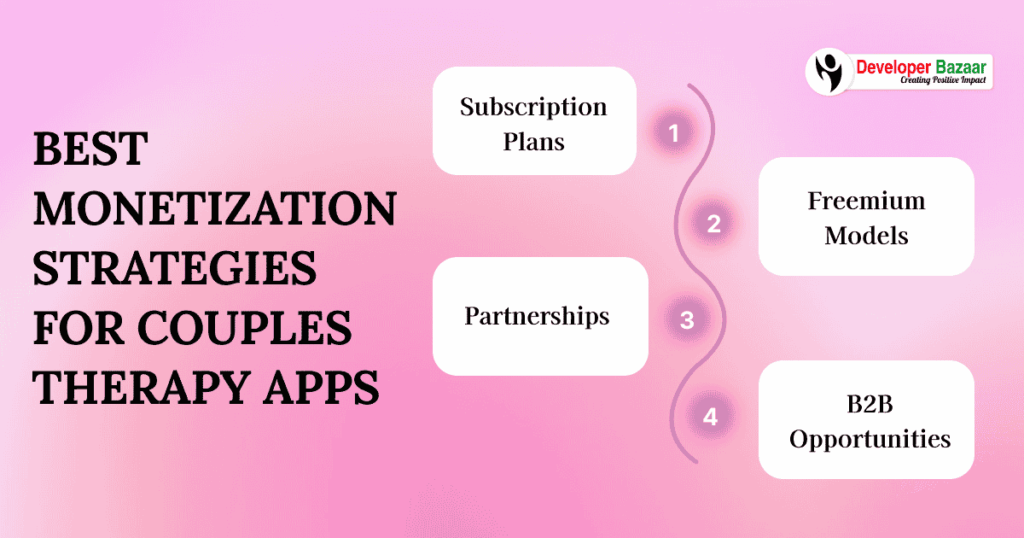
Subscription Plans and Premium Upsells
Offering subscription models is one of the most reliable ways to create predictable revenue. Monthly plans priced between $9.99 and $19.99 keep services affordable while generating steady income. Annual subscriptions, often paired with discounted rates, encourage long-term commitment and improve customer lifetime value.
In addition to subscriptions, you can include premium therapy session upsells, where users pay per video consultation with licensed therapists. This hybrid model allows couples to combine self-guided learning with professional support as needed, with sessions typically priced between $75 and $150 each.
Freemium Models and Feature Upgrades
A freemium approach gives users access to essential features—like basic communication exercises and relationship assessments—at no cost, lowering barriers to adoption. Advanced content such as guided therapy modules, personalized coaching, and detailed progress analytics can be locked behind premium tiers.
This model allows users to experience meaningful value before committing to payment. You can also offer premium feature upgrades that include AI-powered insights, detailed relationship reports, unlimited content access, and priority support. These enhancements cater to highly engaged users who are willing to pay more for an elevated experience.
Partnerships and B2B Opportunities
Strategic partnerships can add diversified revenue streams while enhancing user value. Affiliate relationships with relationship coaches, wellness brands, or book publishers let you recommend relevant products and earn commissions. Sponsored content and collaborations with therapists or experts can generate income if carefully aligned with therapeutic goals.
Finally, consider corporate and healthcare partnerships by working with employee assistance programs, insurers, or healthcare providers who want to offer relationship wellness benefits to their members. These B2B agreements can create stable, large-scale revenue channels beyond individual app users.
ROI Potential and Time to Break Even
Understanding the financial outlook of a couples therapy app is essential for setting realistic goals and securing investment. From acquisition timelines to revenue projections, these insights will help you plan for profitability and sustainable growth.
User Acquisition Timeline
Expect 3-6 months to establish initial user traction through targeted marketing campaigns, content marketing, and strategic partnerships. Mental health apps typically require longer acquisition periods due to the personal nature of the service.
Revenue Projections
Average annual revenue per paying user ranges from $100 to $200, with premium subscribers and therapy session users contributing significantly more. Plan for 5-10% conversion rates from free to paid users, which is typical for freemium mental health applications.
Break-Even Analysis
Most couples therapy apps achieve break-even within 12-18 months, depending on initial marketing investment and user acquisition costs. Focus on retention strategies to maximize customer lifetime value and accelerate profitability.
Market Penetration Strategy
Begin with English-speaking markets (US, UK, Australia) where demand for digital mental health solutions is highest. Expand to other regions once you’ve established product-market fit and optimized your user acquisition funnel.
Growth Acceleration Tactics
Leverage search engine optimization, influencer partnerships with relationship experts, and strategic partnerships with mental health professionals to build credibility and accelerate user acquisition.
Conclusion
Couples therapy apps represent a transformative opportunity in the rapidly growing mental health technology market. As more couples seek convenient, private, and effective solutions for relationship challenges, 2025 presents an ideal time to invest in this promising sector.
Success in this market requires more than just technical expertise—it demands a deep understanding of therapeutic principles, user psychology, and the regulatory landscape. With the right mobile app development company and a clear strategic vision, you can create a platform that not only generates sustainable revenue but also genuinely improves relationships and lives.
The market opportunity is substantial, the technology is proven, and the need is undeniable. The question isn’t whether couples therapy apps will succeed, but which platforms will emerge as the trusted leaders in this space
FAQs
Q1. How much does it cost to develop a couples therapy app like Lasting?
Development costs range from $30,000 to $200,000 depending on features, compliance requirements, and platform complexity. Basic MVP versions start around $30,000, while advanced platforms with AI recommendations and live therapy integration can exceed $200,000.
Q2. How long does it take to develop a couples therapy app?
The development timeline typically runs 4–12+ months. Simpler apps with core features can be launched in 4–6 months, while standard platforms take 6–9 months, and advanced solutions with comprehensive integrations often require 9–12 months or longer.
Q3. What monetization models work best for couples therapy apps?
The most effective models combine monthly or annual subscriptions ($9.99–$19.99), pay-per-session therapy consultations ($75–$150 per session), and freemium access with premium feature upgrades. This hybrid approach balances accessibility for new users with strong revenue potential from engaged subscribers.

RM Mishra
Co-Founder
Developer Bazaar technologies
